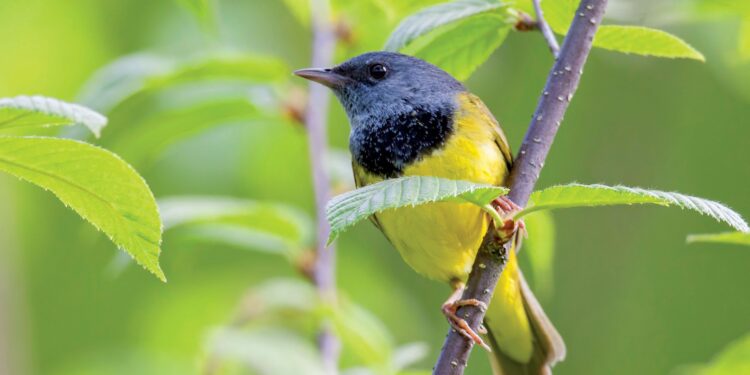One of the most sought-after species for Adirondack birders
By Joan Collins
Warblers are the colorful “butterflies” of the bird world that fill our forests with lovely songs in spring. There are 53 warbler species in North America. With nearly 30 breeding in northern New York, it is one of the best locations to see and hear them.
The mourning warbler is one of the most sought-after by birders visiting the Adirondacks. It is an elusive and hard to see species spending most of its time low in dense thickets. In migration, it is solitary and forages in shrubby vegetation. Birders to our south rarely catch a view of this skulking warbler as it heads north in spring, so it is commonly on their wish list of species to see in our area.
The Adirondack Explorer thanks its advertising partners. Become one of them.
Mourning warblers are elegant looking birds. They have olive-green upper parts, yellow underparts, a gray hood, and males have a black patch on their throat and chest. Alexander Wilson discovered the bird in 1810 near Philadelphia and the dark hood and black patch reminded him of one in mourning, hence the species name.
Their breeding range in Canada is from Alberta east to Newfoundland. In the U.S., their range includes northern New England, New York, the Great Lakes Region and isolated populations in the Appalachian range. They winter in southern Central America and northern South America.
One of the latest warbler species to return in spring, they arrive in mid-May. They are a “circum” Gulf of Mexico migrant traveling over land along the eastern edge of Mexico into Texas, as opposed to “trans” gulf migrants that simply fly over the water.
Shrub dwellers
Their dense, shrubby nesting habitat is often a result of human activity such as logging, power grid corridors and road building, and natural disturbances like storms, fires and insect outbreaks.
The Adirondack Explorer thanks its advertising partners. Become one of them.
Within a couple years, these areas often have thorny vegetation such as raspberry and blackberry bushes favored by mourning warblers. It is a painful habitat to venture into for some of us. After about seven to 10 years, as trees begin to dominate shrubs, the habitat becomes unsuitable.
Nests are on or near the ground in dense shrubs or ferns.
Mourning warblers are insectivorous on the breeding grounds, eating caterpillars, beetles, other insect larvae and spiders. I have observed them feast on mayflies also. During migration, and on the winter grounds, they add fruit to their diet.
Songs are loud and have a burry quality. It sounds like, churry, churry, churry, chur-or. There are four distinct regiolects in their breeding range. This is common with most species, so recordings usually list specific location information.
The Adirondack Explorer thanks its advertising partners. Become one of them.
Hard to view
Birders often complain of “warbler neck” referring to the pain caused from staring straight up into trees for long periods of time trying to spot singing birds.
A mourning warbler is particularly challenging to view. The male perches high in a leafy deciduous tree to sing its burry song, which is a difficult sound to isolate. It’s comical to see a large group of birders surround a tree with a singing bird that they can’t find, even with all those eyes searching.
With an estimated population of 16 million, the mourning warbler is listed as a bird of “least concern.” Breeding Bird Survey data, however, show a yearly decline of 1.2% from 1966 to 2015 for a cumulative population decline of 45% over the period. If this trend continues, the listing will likely change.
Mourning warblers face threats during migration from extreme storms with strong winds, heavy rain and hail. They collide with man-made structures such as buildings, windows and communication towers. Compared to other species, they are 19 times more likely to strike low-rise buildings. Predators like squirrels, chipmunks and raccoons threaten nests.
The Adirondack Explorer thanks its advertising partners. Become one of them.
I hope readers have a chance to see this beautiful bird and hear its lovely song.
Don’t miss out
This article first appeared in a recent issue of Adirondack Explorer magazine.
Subscribe today to get 7 issues a year delivered to your mailbox and/or inbox!
Source link : http://www.bing.com/news/apiclick.aspx?ref=FexRss&aid=&tid=66d000aa3b954f1e95e479403ba0cf69&url=https%3A%2F%2Fwww.adirondackexplorer.org%2Fstories%2Fmourning-warbler-birdwatch&c=16153759563012866499&mkt=en-us
Author :
Publish date : 2024-08-27 23:28:00
Copyright for syndicated content belongs to the linked Source.












